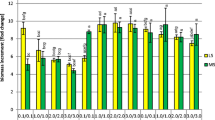Abstract
Rhizoctonia repens M 32, a mycorrhizal isolate from Orchis militaris requires both a carbohydrate (glucose or sucrose) and an amino acid (aspartic acid, glycine, serine, or glutamic acid) for growth. The fungus does not require an exogenous supply of vitamins in vitro.
Similar content being viewed by others
References
Arditti, J. 1967. Factors affecting the germination of orchid seeds. Bot. Rev. 33: 1–97.
Bernard, N. 1899. Sur la germination du Neottia nidus-avis. C. R. Acad. Sci., Paris, 128: 1253–1255.
Bernard, N. 1909. L'évolution dans la symbiose, les orchidées et leurs champignons commençaux. Ann. Sci. Nat., Bot., Ser. 9, No. 9: 1–196.
Burgeff, H. 1936. Samenkeimung der Orchideen. G. Fisher, Jena.
Burgeff, H. 1959. The Mycorrhiza of Orchids. pag. 361–395. In C. L. Withner ed., The Orchids. Roland Press, New York.
Cochrane, V. W. 1958. Physiology of Fungi. John Wiley & Sons, Inc. New York.
Downie, D. G. 1949. The germination of Goodyera repens. (L.) R. Br. in fungal extract. Trans. and Proc. Bot. Soc. Edinburgh 35: 120–125.
Ernst, R., J. Arditti & P. L. Healey. 1971. Carbohydrate physiology of orchid seedlings. II. Hydrolysis and effects of oligosaccharides. Amer. J. Bot. 58: 827–835.
Gottlieb, D. & O. Ciferri. 1956. Deamination and degradation of amino acids by Streptomycetes. Mycologia 48: 253–263.
Hackskaylo, J., V. G. Lilly & H. L. Barnett. 1954. Growth of fungi on three sources of nitrogen. Mycologia 46: 691–701.
Hadley, G. 1969. Cellulose as a carbon source for orchid mycorrhiza. New Phytol. 69: 1015–1023.
Hadley, G. 1970. Non-specificity of symbiotic infection in orchid mycorrhiza. New Phytol. 69: 1015–1023.
Harley, J. L. 1969. The Biology of Mycorrhiza. 2nd ed. Leonard Hill, London.
Harrison, C. R. & J. Arditti. 1970. Growing orchids from seed. Orchid Digest 34: 199–204.
Harvais, G. & G. Hadley. 1967a. The development of Orchis purpurella in asymbiotic and inoculated cultures. New Phytol. 66: 217–230.
Harvais, G. & G. Hadley. 1967b. The relation between host and endophyte in orchid mycorrhiza. New Phytol. 66: 205–215.
Hijner, J. & J. Arditti. 1973. Orchid mycorrhiza: Vitamin production and requirements by the symbionts. Amer. J. Bot. 60(8): 829–835.
Holländer, S. 1932. Ernährungsphysiologische Untersuchungen an Wurzelpilzen saprophytisch lebender Orchideen. Inaugural-Dissertation, Bayerische Julius-Maximilian-Universität, Würzburg.
Knudson, L. 1921. La germinación no simbiótica de las semillas de orquideas. Bol. Real. Soc. Española Hist. Nat. 21: 250–260.
Knudson, L. 1922. Non symbiotic germination of orchid seeds. Bot. Gaz. 73: 1–25.
Knudson, L. 1946. A new nutrient solution for germination of orchid seed. Amer. Orch. Soc. Bull. 15: 214–217.
Lilly, V. G. & H. L. Barnett. 1951. Physiology of the Fungi. McGraw-Hill Book Co. Inc., New York.
Mariat, F. 1948. Influence des facteurs de croissance sur le dévelopment et la différenciation des embryons d'orchidées. Rev. Gen. Bot. 55: 229–243.
Mariat, F. 1951. Contribution à l'étude de la symbiose dans ses rapports avec les facteurs de croissance. Dissertation, Faculty of Sciences, University of Paris.
Mitra, S. K. & R. N. Tandon. 1970. Nitrogen requirements of three species of Pestalotia. Mycopath. et Mycol. app. 42 (1–2): 9–16.
Ramsbottom, J. 1922. The germination of orchid seed. Orchid Rev. 30: 197–202.
Robbins, W. J. 1937. The assimilation by plants of various forms of nitrogen. Amer. J. Bot. 24: 243–250.
Smith, S. E. 1966. Physiology and ecology of orchid mycorrhizal fungi with reference to seedling nutrition. New Phytol. 65: 488–499.
Smith, S. E. 1967. Carbohydrate translocation in orchid mycorrhizas. New Phytol. 66: 371–378.
Steinberg, R. A. 1950. Growth of fungi in synthetic nutrient solutions. Bot. Rev. 16: 208–228.
Stephen, R. C. & C. Chan. 1970. Nitrogen requirements of the genus Linderina. Can. J. Bot. 48: 695–698.
Stephen, R. C. & K. K. Fung. 1971. Vitamin requirements of the fungal endophytes of Arundina chinensis. Can. J. Bot. 49: 411–415.
Vermeulen, P. 1947. Studies on Dactylorchis. Dissertation, University of Amsterdam.
Warcup, J. H. & P. H. B. Talbot. 1967. Perfect stages of Rhizoctonia associated with orchids. New Phytol. 66: 631–641.
Author information
Authors and Affiliations
Rights and permissions
About this article
Cite this article
Powell, K.B., Arditti, J. Growth requirements of Rhizoctonia repens M 32. Mycopathologia 55, 163–167 (1975). https://doi.org/10.1007/BF00491502
Accepted:
Issue Date:
DOI: https://doi.org/10.1007/BF00491502




